Mitsubishi Outlander PHEV

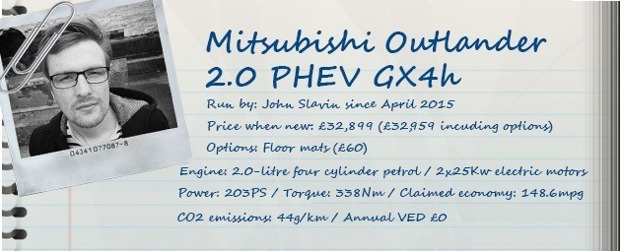
- Welcome to the future
- Keeping the batteries charged
- Playing the regeneration game
- The Outlander’s sat nav is evil
- How practical is the Outlander?
- Company car driver? Here’s your new car
- What are the alternatives?
- A second opinion: First impressions
- A second opinion: Conclusions
- Outlander gets a new face
- Where's the infrastructure
- Waving off the Outlander
Welcome to the future
We welcome the plug-in hybrid Mitsubishi Outlander. Part electric car, part petrol car, all futuristic.

Date: 27 April 2015 | Current mileage: 750 | Claimed economy: 148.6mpg | Actual economy: 49.3mpg
Once upon a time, big SUVs were the enemy. Crushing baby animals, destroying fields and boiling the oceans, these gas-guzzlers were the root cause of all evil in the world. But the Outlander PHEV is different - because it is a plug-in, petrol-electric hybrid and officially it can do 148mpg, emitting just 44g/km of CO2.
You wouldn’t guess that by looking at it though. The first impression I had when our blue rinse-coloured Outlander PHEV arrived was "wow, that’s pretty large". In fact, if you strip away all the plug-in hybrid planet-friendly pretensions the Outlander is more or less exactly what an SUV should be.
It’s tall, long and chunkily-styled, with four-wheel drive and loads of space in both the boot and the back row. From the driver’s seat there is a commanding view forward and down the prominent bonnet, but when you press the start button there is no grumbling, ratting diesel noise. In fact there is nothing at all.
The Outlander PHEV makes no sound, other than a cacophony of bongs if you forget to buckle your seat belt immediately upon sitting down. The only thing that you can hear from the powertrain is the faint whir of the electric motors and the crunch of gravel under the wheels. The engine only kicks in when accelerating hard or when the battery is completely dead, which isn’t often. Since driving along at least partially charges it, at low speeds the PHEV is pretty much entirely an EV.
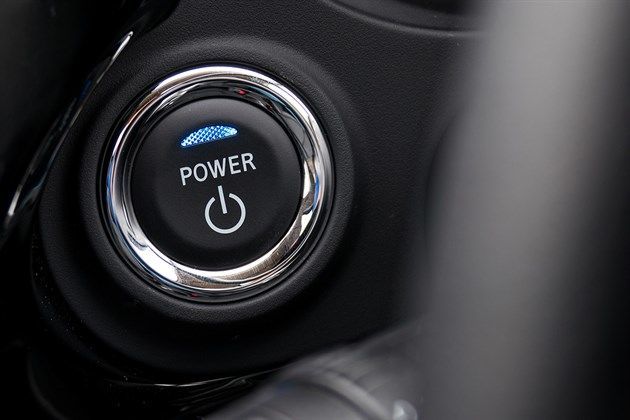
An illuminated button is necessary, since there is usually no noise
Charging the battery from a three-pin socket takes about five hours from empty to full, which gives a theoretical range of 30 miles on EV power alone. In reality the range is closer to 20 miles, but for commuting that is absolutely fine. You can also boost the battery up to 80 per cent in under 30 minutes by hooking up a fast charger, like those provided by Ecotricity in motorway services.
Given the fact I only charge the Outlander in places where someone else pays the bill I can get quite a long way for free – but once the battery is out of charge and the 2.0-litre petrol engine starts up the official economy figures mean nothing. On a long journey (and I cover a lot of miles) typical economy is about 40mpg. A long way short of 148mpg, but for a big, petrol-powered all-wheel drive SUV that’s not bad at all.
The first few journeys have been a learning experience. Maximising EV range becomes something of an obsession - coasting the car, being gentle with the throttle, plotting routes that pass fast charging points and using the regenerative brakes all become an essential part of a journey. Thankfully they aren’t a distracting part of a journey, since range anxiety is irrelevant provided you can find petrol. In fact, nothing is distracting on a long trip – the Outlander is quiet, comfortable and easy to drive thanks to the automatic transmission. You just put it in D and go.
First impressions are very good, but there are lots of things to think about with a plug-in hybrid besides how impressive the car is. What is the charging infrastructure like in the UK? Does a plug-in really make financial sense for a long distance driver? Hopefully we’ll find out in the coming months.
Keeping the batteries charged
Keeping the Outlander PHEV topped up is essential if you want to make the most of a tank of petrol - these are the methods.
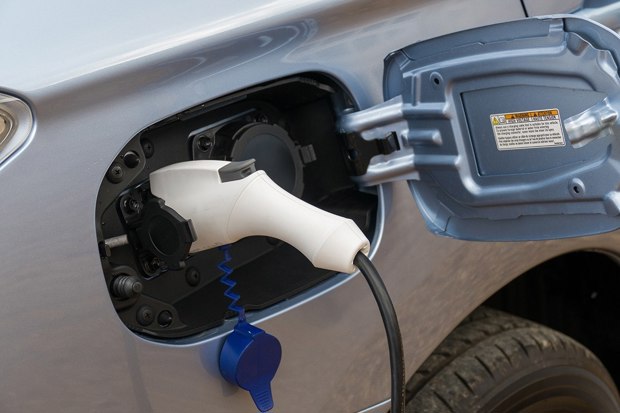
Date: 11 May 2015 | Current mileage: 1210 | Claimed economy: 148.6mpg | Actual economy: 75.6mpg
If you’re planning on buying a plug-in hybrid like the Mitsubishi Outlander PHEV, you’ll almost certainly be wondering about charging and infrastructure. Keeping the battery topped up is essential whether you’re eco-conscious and want to reduce your emissions, or if you just want to save some money on petrol.
Thankfully charging the Outlander PHEV at home or at work via a three-pin socket is very, very easy. On the left side of the car there is a fuel filler flap, while on the right hand side there is a flap covering two sockets. The little one is for the provided three-pin charger, which you can use with any standard plug socket, while the larger socket is for fast chargers.
For a slow, three-pin charge you plug both ends in, flip the switch and voila - the charging starts. A solid green light on the charging unit means charging is in progress, a flashing green light means charging has completed. This takes about five hours from empty. It’s worth noting that you can’t connect the charger to an extension – apparently that isn’t safe.
From the settings menu in the car you can tell the charge to start at a specific time, so if you hook it up before bed you can tell it not to charge until after midnight, which might be useful for some electricity tariffs. Charging the car from empty costs around £1 according to Mitsubishi and, realistically, that will get you around 25 miles. Doing 25 miles in the diesel auto, based on official figures and a diesel cost of £1.19 per litre, would cost £2.22.
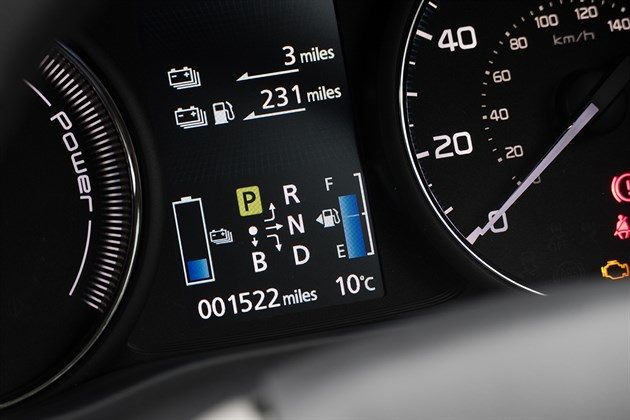
Keep the left bar full for good times
That’s not the whole picture though, because there are various free places to charge, including (once you have paid a £10 membership fee) at most motorway service stations, thanks to Ecotricity. You can also get a Source card which lets you charge (and in some cases park) for free in numerous shopping centres and towns. Zap Map is a useful tool for finding a charger.
Nothing is ever problem-free, though. Only a three-pin charger is provided for free by Mitsubishi, so you’ll have to pay for an additional cable if you want to use most charging points. The exceptions are Ecotricity points, since they have cables attached – you just pick the right one, follow the instructions and come back when the charge is finished.
Charging from an Ecotricity fast charger takes about 25 minutes and tops the battery up to 80 per cent. That means you can stop in at a services, hook up, and then by the time you’ve got your Greggs pasty you'll be on your way with some free miles. Unfortunately some motorway services don’t have Ecotricity points, while of those we’ve visited so far several have been out of order.
You also have to hope there isn’t anyone else there – as time wears on and electric cars become more popular the chances of finding a free charging point get slimmer. That is the beauty of the PHEV, though – if you can’t charge up then you can still continue on your journey, you’ll just burn a bit more fuel.
Playing the regeneration game
The Outlander has paddles for choosing one of five levels of regenerative braking - mastering them can add miles to the range.
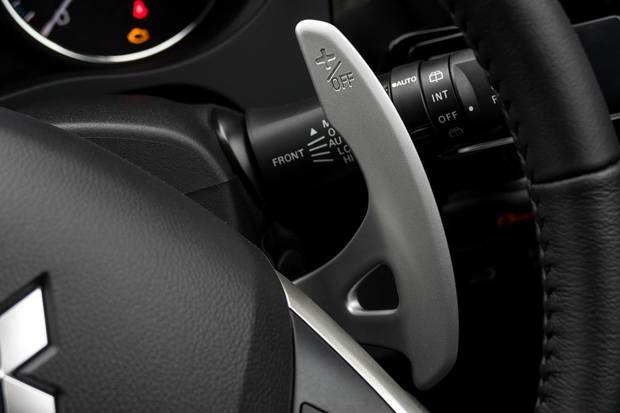
Date: 2 June 2015 | Current mileage: 1763 | Claimed economy: 148.6mpg | Actual economy: 50.7mpg
Just like in a rowing competition, keeping the Outlander moving along efficiently requires careful use of the paddles - but on the Mitsubishi they are made of metal and sprout out of the steering column. They also take a lot less effort to operate than those on a boat and don’t require any kind of teamwork.
On the Mitsubishi the paddles don’t operate the gearbox – because there isn’t one. Instead, they let you choose the level of regeneration available when lifting off the throttle pedal, from zero to five. Zero is no regen at all, five is a lot - and it turns out making the most of this function takes a lot of forethought.
The regen system on the Outlander translates slowing down into extra juice for the battery. By default, selecting Drive on the gear selector gives you level two regen, which makes the car feel like normal automatic. Backing off the gas pedal gives you some deceleration, much like engine braking on a regular petrol-powered car.
Flicking the left paddle increases the level of regen one step at a time to the maximum of five. At level five lifting off the gas pedal causes the car to noticeably slow down, without any pressure on the brake. This is great in town, where you’re likely to be stopping and starting a lot.
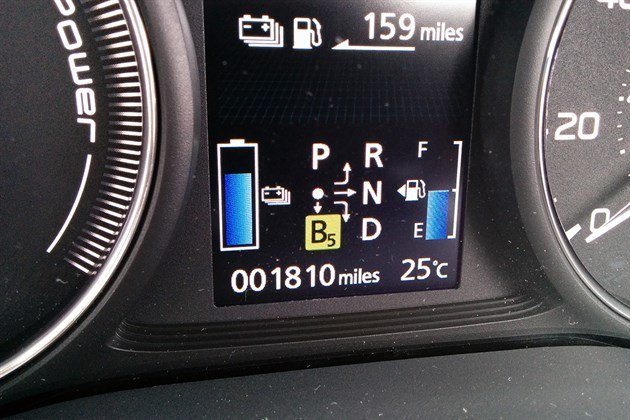
The green 'B5' means maximum regen
Obviously this is all done for a reason – deceleration on most cars is almost entirely down to the brake pads and discs, but these are inefficient – friction and heat effectively waste the energy that was used to get you up to speed. The regen system on the Outlander harnesses much of the energy used to accelerate and puts it back in the battery.
The pads and discs then get used less harshly than they would with no regeneration system. This gives another saving when it comes to replacement parts, since the pads and discs last longer. You might think, then, that the regen should be set to maximum all the time? But it’s often better for the EV range to turn it off entirely.
With zero regen the car coasts along, picking up speed on downhill sections and rolling along on straight roads, all the while consuming no fuel. Touching the brake pedal gently still initiates regenerative braking first, before the pads and discs, so when you do need to slow down you still save a lot of energy.
It’s possible to coast more than a mile on my commute – something learned through practice. In fact I now intuitively know what level of regen to use in what situation, which means I am always using the left and right paddles. Like on a boat.
The Outlander’s sat nav is evil
The navigation system in the Outlander seems to be haunted by the ghost of a demon headmistress...
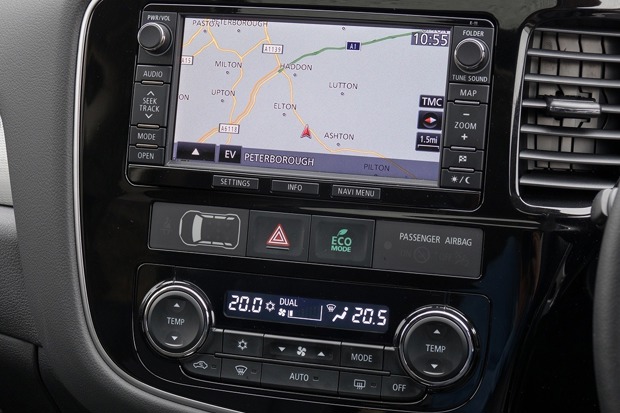
Date: 16 June 2015 | Current mileage: 2382 | Claimed economy: 148.6mpg | Actual economy: 63.3mpg
With all its fanciful technology, it’s no surprise the Outlander has a fairly comprehensive infotainment system. There’s a large touchscreen system at the top of the centre stack which controls everything from Bluetooth and music, to monitoring your driving behaviour and battery usage.
Unfortunately, while it does have lots of useful features, it’s a bit messy and ugly. The buttons around the screen, which take you to sub menus, aren’t laid out with any kind of logic. Obviously you get used to what is where in time, but there’s always a lot of confusing clutter on screen. In fact even after a couple of months with the car I still occasionally get lost in the menus from time to time.
Our Outlander has a built-in navigation system which works fairly well. Programming in a destination is straightforward if you have the postcode, plus it shows a largely accurate ETA - but it doesn’t show traffic problems on the route very promptly. That means I tend to avoid using the built-in system and instead use Waze on a mobile phone, since it has up-to-the-minute traffic info.
The other big problem with the built-in navigation system is the voice. The woman must have been seriously angry or bored when she recorded the various directions and numbers - she sounds like a cross between an evil Disney witch and a life-wearied headmistress. I daren’t make a driving mistake in case she jumps out and strangles me.
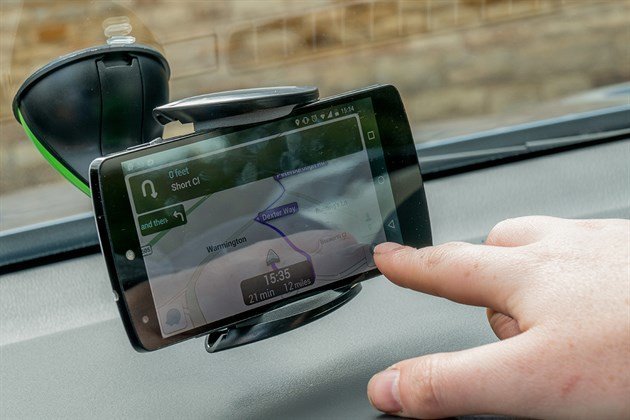
I prefer navigating with my phone over the built-in nav
So the built-in navigation tends to stay switched off. The rest of the infotainment isn’t too bad at all, though, once you get your head around the interface. Bluetooth works well - pairing up a phone and streaming Spotify is easy plus it usually displays artist and track information, though it does sometimes forget. Phone calls are clear through the Bluetooth system although I don’t tend to make or receive them when driving.
There are some more advanced features built in. You can tell the car to pre-heat or pre-cool the cabin for ten minutes at a specific time of day. You choose a day of the week and a time in advance, so you can have the cabin warmed up on weekeday mornings before you leave for work during the winter, or having it cooled before hometime in the summer.
You can also tell the car when to start charging up from the mains in order to take advantage of cheaper electricity at certain times of day. What’s more, these functions can be controlled remotely via a mobile phone - so if you want to turn your pre-heat off because of a change in weather you can do it from the house or office, provided the car is in range.
It’s not perfect, though. Linking the phone app to the car is a fiddle and the app itself is hardly the most beautifully designed or user-friendly. It also works via WiFi, rather than Bluetooth, so you can sometimes find your phone automatically trying to connect to the internet through the car (which doesn’t work) instead of via a proper WiFi hotspot. Still - it does the job. And how many other cars can you control from your phone?
How practical is the Outlander?
What fits in an Outlander? Rather a lot of stuff, it turns out. John finds out as he buys an old moped.

Date: 30 June 2015 | Current mileage: 2956 | Claimed economy: 148.6mpg | Actual economy: 63.3mpg
I’ve talked in depth about how the Outlander PHEV runs on a combination of electricity and petrol and how you can commute for almost nothing, but I’ve barely mentioned how useful it is as a car in the traditional sense. Which is a bit remiss of me, since it’s about as practical and user-friendly as cars come, with a huge boot and masses of legroom.
For everyday use the Outlander is great. Our car has an electric tailgate which takes quite a long time to raise and lower, but if you’re carrying heavy stuff it’s easier to press the open button on the keyfob than to put everything down and find the button on the boot. There is an override button in the car that disables the electric function - then the hatchback raises and lowers on gas struts like on any other car.
Folding and unfolding the rear row of seats is easy enough to do, despite the lack of electronic one-touch levers. With everything folded the load deck is flat and level with the load lip, which makes sliding heavy stuff in and out really easy. That proved useful just a few weeks into my time with the car.
I put the Outlanders' spaciousness to the test by buying a knackered old moped. Most of the engine was missing, it was 50 miles away and it only cost £85, so hiring a van or a company to help out was a bit of a waste of money. Thankfully, with the rear seats folded flat, the scooter fit in fine - it took two people to get it in and out, but that was purely down to its awkward shape.

Lots can fit in here. Even a small motorbike...
The problem with loading a scooter into the back of a car on its side is that it leaks two-stroke oil all over the place - but Mitsubishi kindly fits a rubber load area protecter to the Outlander. It took some scrubbing to get ride of all the smelly old gloop, but it’s as good as new now - just like the scooter.
If you're carrying humans instead of bikes, the rear seats in the Outlander are great. They don’t just fold flat, they also recline, which means rear seat passengers can get comfortable easily. Head room and leg room are generous, with plenty of space for adults in the rear row. If you really need space you can also get the Outlander PHEV with two additional, small seats that fold out of the boot.
Ours is the five-seater though, which is fine - we have no children to carry about the place. In fact most of the time it’s just one or two people in the car - which perhaps renders its spaciousness pointless. But after six months with a little Skoda Citigo the space in the Outlander is really, really useful - if I want to go and get something big and bulky I can without worrying about getting it home.
Aside from testing the boot capacity it’s been plain sailing with the Outlander. It’s been a little warmer lately, which means using the air conditioning. And that means reducing the battery range a touch. Even so it's possible to get home from work and almost the whole way back to the office - around 35 miles - on electricity alone. I don't think that will ever get old.
Company car driver? Here’s your new car
The Outlander PHEV is a fantastic company car, thanks to BIK benefits that will save many drivers thousands of pounds.

Date: 14 July 2015 | Current mileage: 3362 | Claimed economy: 148.6mpg | Actual economy: 63.3mpg
A company car is a nice perk, but it doesn’t come free. As with everything nice there is a tax to pay, called Benefit in Kind (BIK). It depends on a number of factors including the type of fuel, the value of the car and the driver’s income. For many that puts a big SUV out of reach – but the Outlander PHEV falls into the sweet spot.
The numbers speak for themselves. A Mitsubishi Outlander GX4 diesel automatic costs £31,899 while a GX4h PHEV costs £32,899 after the Government’s greener vehicle discount. The diesel emits 153g/km of CO2, which places it in the 26 per cent BIK band. A 20 per cent company car driver would therefore pay approximately £1660 a year in BIK for it.
The PHEV, however, falls in to the five per cent BIK band. That’s the lowest rate for any kind of vehicle aside from a pure EV. Calculations are based on the list price of the vehicle, so the greener vehicle discount isn’t taken into account for the calculation, but even so a 20 per cent company car driver would pay just £379 a year in BIK.
That means choosing a PHEV over a diesel saves a company car driver £1281 a year in BIK – plus they can do most of their commute for next to free on electric power. It’s a no-brainer, really – if you’re looking for an SUV as your company car then there’s every reason to consider the Outlander PHEV.

A wallet-friendly badge
The savings are even greater if you commute into central London every day, since the Outlander PHEV is congestion charge exempt. Thanks to its emissions falling below the 75g/km threshold the Outlander PHEV just needs to be registered at a cost of £10, following which there is no daily charge at all, potentially saving thousands every year.
Currently Outlander PHEV buyers and owners don’t have to pay for road tax (or VED, as it’s officially called), since emissions are below 100g/km. But from April 1 2017 this will no longer be the case, thanks to some government tax tinkering. From then VED will be a straight £140 each year for all cars.
There are two exceptions – pure EVs will still qualify for free annual VED and cars priced at more than £40,000 will pay a surcharge of an additional £310 per year for five years. VED bands based on CO2 do still exist, though – but they only make a difference when you buy the car. The first year rate for the Outlander PHEV will be £10, but for high emission vehicles this can be as much as £2000. Ouch.
The nice thing about this is that it isn’t retrospective, so if you already own an Outlander PHEV or if you buy one before April 2017 then you’ll benefit from free VED forever. And besides, the £140 cost of VED from 2017 onwards won’t dull the Outlander PHEV’s appeal to company car drivers – it’ll still be much cheaper in BIK than a diesel.
What are the alternatives?
If you've settled on the idea of driving a pluh-in hybrid, what other options are there aside from the Outlander?
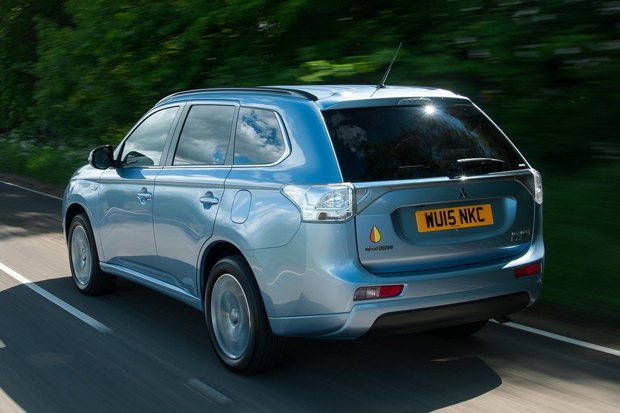
Date: 24 August 2015 | Current mileage: 3890 | Claimed economy: 148.6mpg | Actual economy: 63.2mpg
The Outlander PHEV is one of the most popular plug-in hybrids on sale, but it isn’t the only one. In fact there are increasing numbers of plug-in models appearing in the model ranges of every kind of car manufacturer, from exotic brands like McLaren, with its P1, to Vauxhall with the less than successful Ampera.
In fact there are quite a few options if you want to blend petrol and electric drive. All have similar benefits when it comes to economical commuting and company car tax. Our Outlander cost a little less than £33,000 – so a McLaren P1 is out of the question – but what other plug-in hybrids are available for similar money?
One model that comes close to matching the Outlander PHEV on price is the Volkswagen Golf GTE. After the government plug-in car discount of £5000 it comes in at a cheaper £30,520 in top Nav trim – plus it is nicely finished and has impressive performance, thanks to peak power of 204PS.
But compared to the Outlander PHEV it’s tiny. There aren’t many scenarios in which you would compare a medium-sized family hatchback to a large SUV – so it isn’t fair to do so here. The Golf might be cheaper and better to drive – but so it should be.
Volkswagen has a larger PHEV on the way in the form of the Passat GTE estate, though. Prices are to be confirmed but we estimate it will cost almost exactly the same as the Outlander PHEV after the government discount. This is certainly a more valid competitor for the Outlander.
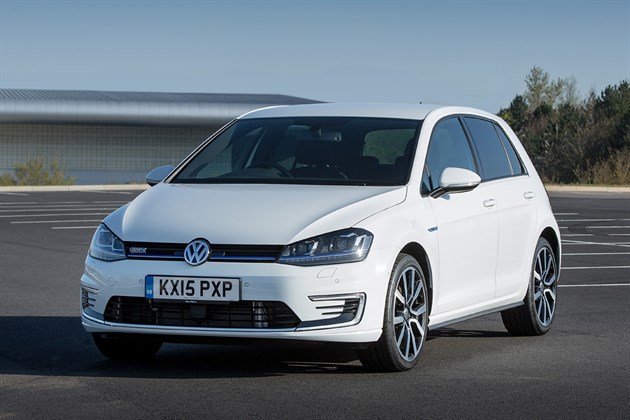
Golf GTE. Cheaper. Smaller.
The Passat GTE estate has a sizeable boot, plus it is smooth and quiet – but there is still a lot in the Outlander’s favour, again because of its size. It is a full-sized SUV with a raised driving position and, even though the Passat is big, the Outlander is still the larger car.
Mitsubishi doesn’t have a complete monopoly when it comes to plug-in hybrid SUVs though. In fact there are plug-in variants of the Porsche Cayenne, BMW X5, Audi Q7 and Volvo XC90 – but they’re all significantly more expensive than the Outlander PHEV.
They may be nicer to drive and to be in than the Outlander, but then you’d hope so given the premium you have to pay. But this leaves the Outlander in a league of its own – there really isn’t anything on sale that is the same size, at the same price, with the same plug-in technology.
That won’t last forever, of course. Car makers don’t tend to rest on their laurels, particularly when there’s an opportunity to be seized upon, so over the coming years you can rest assured that other car manufacturers will come up with very similar vehicles at very similar prices. For now, though, the Outlander PHEV is the only big, company car tax friendly plug-in SUV you can get for around £33,000.
A second opinion: First impressions
John hands the Outlander over to Matt Vosper for a couple of weeks to see if it suits his high mileage driving.

Date: 7 September 2015 | Current mileage: 4362 | Claimed economy: 148.6mpg | Actual economy: 52.3mpg
John hands the Outlander over to Matt Vosper for a couple of weeks to see if it suits his high mileage driving...
"I have been lucky enough to drive John's Mitsubishi Outlander PHEV for a couple of weeks while he’s been out globetrotting the world, testing all kinds of other cars. Before I collected it I was quite looking forward to trying out the plug in hybrid technology to find out what it’s all about.
I’d often find John busily tapping away at his keyboard in the office and next to him was a cable, trailing from the wall plug out of the window into the car park, where it was connected to what looks like the petrol filler cap of the Outlander, but is actually the charging socket.
I know John is pretty pleased with this car and it's easy to see why when it comes to size, which is ideal for me with all my camera equipment. But I do travel quite a few miles, certainly more than John does on a weekly basis - such is the nature of my job. So does the hybrid tech work for all drivers?
In John’s case, he can get to the office and back very nearly without using any fuel at all, but that’s not the case for me. I'm not sure that will be the case for me...
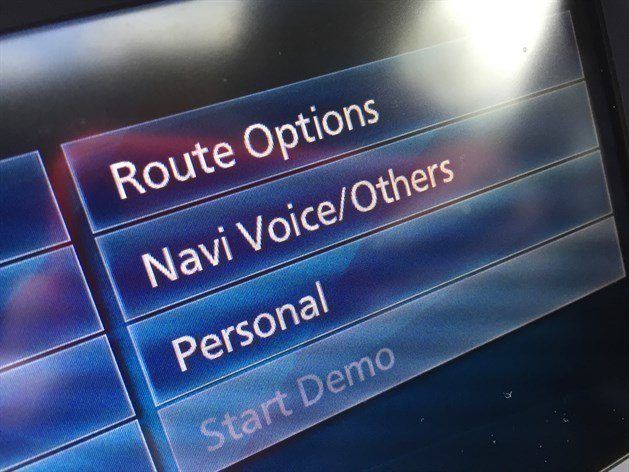
It's the demon headmistress, trapped behind a screen
The cabin is very spacious with decent visibility, it’s very comfortable on long runs and in electric mode, albeit with some tyre noise, it is almost silent in operation. The only sound is a kind of futuristic sci-fi type whoosh, which my son absolutely loves being a Star Wars fanatic.
Another, less impressive sound - and something that really does need to be mentioned, as John already has - is the unbelievably sinister woman’s voice when using the navigation. It really is creepy and probably best to turn off voice instructions unless it’s Halloween. It’s all computer generated, but all the same it’s really disconcerting to be guided by a demon headmistress on your way to a meeting.
There is loads of room in the back and there have been no complaints from my children, only that they know I have to hand back the keys to John soon. So from a family car point of view, it does the job more than well, especially as the ride is also very soft and very quiet.
Strangely I have noticed a bit of an oddity in the boot, where there is a set of cupholders on the driver’s side at the very back, but obviously no seats to pop up. This is a hang up from petrol and diesel seven seats variants, but the PHEV has a huge set of batteries under the boot floor instead, which is a shame for a bigger family.
A second opinion: Conclusions
Matt was initially impressed with the space and quietness of the Outlander, but after covering some miles does he still like it?
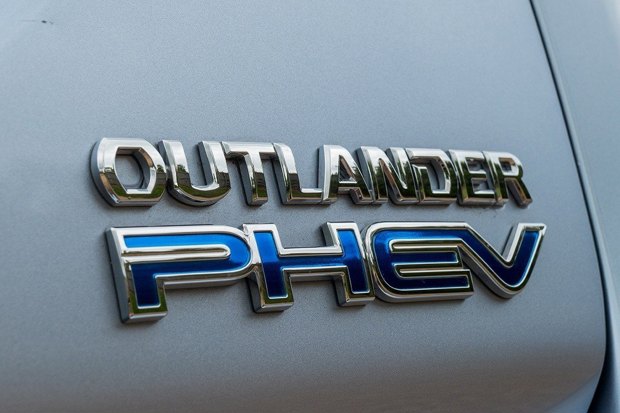
Date: 21 September 2015 | Current mileage: 5124 | Claimed economy: 148.6mpg | Actual economy: 48.1mpg
Although hybrid technology is great and may well be economical and good for the environment, for me it’s just not working. I do like the idea, but it’s a faff. In an ideal electric car, you’d get in and drive just as you would a normal car, but in the Outlander PHEV, you have to both charge it up and fill it with petrol.
It may sound lazy, but in order to match the economy of many admittedly smaller and lighter petrol cars, you have to charge the battery every single time you drive. If you don't you’ll soon see the a hole in your wallet, particularly if you cover a lot of miles.
Here’s the scenario I found virtually every day with this car. Imagine a long day at work, coupled with long drive home in the rain. You're tired and before you've even parked you have to reverse onto the driveway in the dark. Then you have to get out of the car on the wrong side in the rain, open the boot and rummage for the cable, plug in the car, hook up, lock up and then go indoors.
Reverse that the next time you drive, every time. By doing this you're not cheating the system, nor gaining a huge advantage over anyone who doesn't have a hybrid, you're merely getting 31 miles of electric range from the car. Every time you don't do this you end up watching the petrol gauge like a hawk knowing the inevitable and wishing you had plugged the car in.

To maximise economy you'll need to learn to use these
So when you sign on the dotted line for this car you're also committing yourself to doing this from day one, a bit like buying a dog and then walking in the rain for the next few years at 5am until one of you eventually drops.
But thats not all, because if you charge it up you actually gain a maximum of 25 miles of extra range, not 31. And even that I would question, since it rapidly disappears to about five miles after only driving about five miles on the A1. Obviously the electric range lasts much longer in town and off the motorway - but I drive on the motorway a lot.
Something that is clever is the pair of paddles that allows you to regenerate the battery. Pulling them allows you to set the regenerative braking levels. Gauge it right and you’ll hardly ever need to touch the brake pedals at all in normal driving.
But here’s the bottom line for me - my new Dacia Logan MCV costs £50 to fill and you immediately get a range of around 750 miles. No cables, no getting wet, no driving changes, nothing. It might suit some drivers, particularly short distance commuters, but for me a diesel is better. Still, you can get a diesel Outlander if you like…
Outlander gets a new face
Since our Outlander arrived, Mitsubishi has busily beavered away on the design – now Outlanders get updated styling and a few other tweaks.
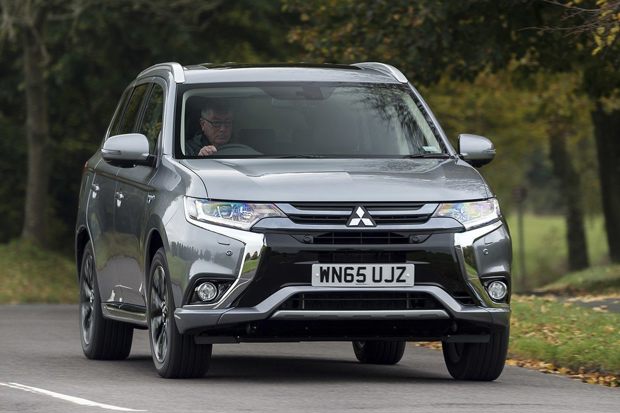
Date: 5 October 2015 | Current mileage: 6395 | Claimed economy: 148.6mpg | Actual economy: 48.1mpg
See that car in the picture? It’s not ours, but it is still an Outlander PHEV. Mitsubishi is calling the facelift its biggest midelife update ever - and it’s easy to see why. The anonymous styling has been replaced with a strong, modern look both front and rear. And yet, underneath it all, the basics are the same as before.
The changes aren’t merely skin deep though. The updated Outlander PHEV has revised suspension with improved ride and handling and tweaked steering. While we haven’t had many complaints about the drive in our Outlander, a bit more weight and bite to the steering is welcome.
The powertrain remains unchanged with the same arrangement of two electric motors – one for each axle – and a petrol engine to generate power. That said, the software has been improved, meaning the new model accelerates slightly faster than our outgoing version.
Range remains the same, which means that most buyers can get to and from work without using much fuel, if any at all. The journey itself should be slightly more pleasant than in the outgoing version though, thanks to some improvements to the fit and finish in the cabin.

Perhaps the biggest criticism we have for our Outlander is the choice of materials inside, including on the dashboard top. It’s not that they’re of poor quality – they’re very durable indeed – it’s just that they don’t look or feel like they belong in a large, fairly expensive car.
This criticism has been addressed in the revised model, which has a new steering wheel, new seats and a new centre console. There have also been plenty of subtle changes to improve noise isolation from the engine, the tyres and the wind, making the Outlander PHEV quieter than it was before – and it was hardly loud.
These changes aren’t for nothing though – you have to pay more for the new Outlander PHEV. Fortunately, in addition to the improved quality and refinement there is some new technology on offer too including a heated steering wheel and a 360-degree around-view camera to make parking easier.
Since the Outlander PHEV went on sale it has been the most popular plug-in model available in the UK, but rivals are catching up – so it’s good (for Mitsubishi at least) that the revised model is so appreciably better than the outgoing car. As for us – we have a few weeks left with the outgoing car, but it keeps providing faithful service.
Where's the infrastructure
Out of order chargers and other EV drivers are getting on my nerves - but fortunately I can always rely on petrol to sort me out.

Date: 19 October 2015 | Current mileage: 7102 | Claimed economy: 148.6mpg | Actual economy: 48.1mpg
Plugging in the Outlander PHEV at a public charging area is great. When I’m on a long journey I often stop at one of the many motorway service stations with an Ecotricity charging station, which boosts my range by about 30 miles for free and it takes next to no time at all.
These charging stations are typically quite close to the entrance too, which makes popping in for a coffee an easier experience, especially in the rain. Unfortunately charging points aren’t always painless though, which I briefly mentioned in an earlier update.
Several times since the Outlander arrived we’ve arrived at a charging station only to find it completely out of order. Since they are unmanned it’s impossible to get someone to pop over and take a look at the machine and attempt to fix it. If it’s out of order, that’s that.
However even when they are working things aren’t always painless. Most service stations – which are where you’re likely to need a quick top up – don’t have enough charging points – so you might find another EV (often an Outlander) hogging all the space and electricity.
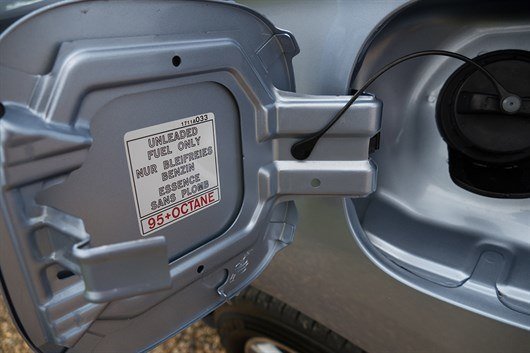
Petrol. A good backup plan.
Obviously you can wait for the owner to come back, but you could be there a long, long time. Obviously I shouldn’t complain too much about the free mileage, but it can be deeply frustrating. It’s even worse for a pure EV owner – what irritates me could completely strand them.
Britain should take note of the way Amsterdam does things. Almost every street has an electric charging station, so there’s almost always a place to charge up, even if one charging station is down, there’ll be another one extremely close by.
Fortunately Britain isn’t resting on its laurels. There are proposals to improve charging infrastructure and to educate motorists on the benefits of choosing an EV. It is still early days for EVs, after all – so some problems, including a lack of charging points, are to be expected.
Besides, the Outlander PHEV doesn’t really even need to be charged – it would carry on working if you only ever fuelled it with petrol. That would defy the point, of course – but it is something of a get out of jail free card – a futuristic, electric car that will work here and now, even if the infrastructure is in its infancy.
Waving off the Outlander
After six months of driving around on a mixture of petrol and electricity, it's time to say goodbye to the Outlander PHEV.

Date: 2 November 2015 | Current mileage: 8693 | Claimed economy: 148.6mpg | Actual economy: 47.9mpg
After six months almost 10,000 miles and a healthy mixture of electricity and petrol, my time with the Outlander PHEV is at its end. It’s certainly been an interesting six months that has altered my approach to driving. Planning journeys to ensure I made the most of the battery pack became part of everyday life.
That said, it’s best to think of the Outlander PHEV as a stepping stone, rather than a true car of the future. But what that means is that it really, genuinely works here and now, despite electric vehicle infrastructure still going through teething problems.
Pure EVs are still a compromise, even though more and more chargers and better battery packs are cropping up almost every day. Even if you drive like a saint it’s impossible to cover 200 miles in a pure EV without stopping to charge up, which takes up valuable time – and that’s not the only problem with chargers.
In the Outlander PHEV you can stop and boost your battery if you feel like it, but it’s not required. Obviously the petrol tank needs to be topped up, but that takes a few seconds rather than more than 25 minutes – plus there are petrol stations everywhere, not just as selected service stations.
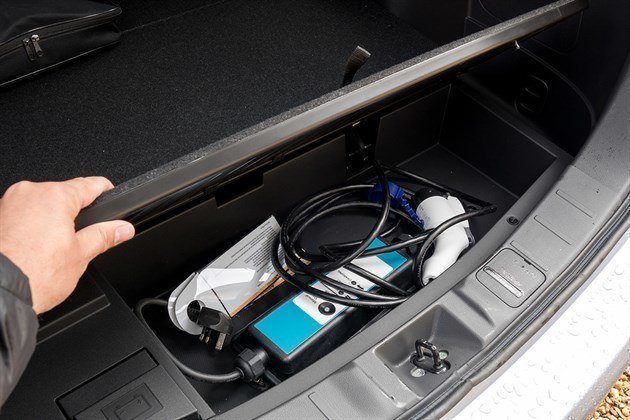
Topping up with this became part of everyday life
Of course, that’s only on long trips. On the daily commute the Outlander PHEV is very much an EV, with a range of around 30 miles. I tended to get more like 20-25, but that’s still enough to get to work without using any fuel at all. And that’s really the point of the Outlander PHEV – it’s an EV when you want it to be or a normal car when you don’t.
That said, there is a strong argument against the Outlander PHEV too. If, like I do, you tend to cover a lot of miles on the motorway, the EV range isn’t much use. If that’s the case then the diesel model is a better bet – but Mitsubishi will sell you a diesel model for about the same price as a PHEV, so you can pick whichever suits you best.
Aside from the plug-in hybrid powertrain, there isn’t anything remarkable about the Outlander PHEV. It’s big, relaxing, comfortable and easy to drive. It’s not the most plush or extravagantly-finished car, but it’s feels solid and durable enough to survive the tribulations of family life.
It’s a shame to see the Outlander go – but for the distances I’ve been covering, I’d probably be better off with something more conventional. That said, if you drive the same short route every day then it’s hard to think of a more wallet-friendly SUV at this price. If you think the PHEV will suit you, then you’re probably right. Otherwise, stick to diesel.
